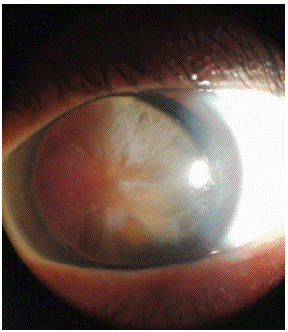
Case Report
Austin J Clin Ophthalmol. 2023; 10(4): 1153.
Posterior Subluxation of Hypermature Cataract
Najoua El Moubarik*; Lina Boualila; Kenza Tazi; lalla Ouafae Cherkaoui
Department of Ophthalmology “A”, Ibn Sina University Hospital (Hôpital des Spécialités), Mohammed V University, Morocco
*Corresponding author: Najoua El Moubarik Department of Ophthalmology “A”, Ibn Sina University Hospital (Hôpital des Spécialités), Mohammed V University, Rabat, Morocco. Email: najoua.elmoubarik@gmail.com
Received: February 07, 2023 Accepted: April 05, 2023 Published: April 12, 2023
Description
We report the case of an 82-year-old female patient who presented to the ophthalmologic emergency room with decreased visual acuity in the right eye for several years. Ophthalmologic examination of the right eye revealed visual acuity reduced to positive light perception, a clear cornea, a subluxated hypermural cataract inferiorly in the posterior segment (Figure 1), and an ocular tone of 30mmhg. An ocular ultrasound was performed and came back without any abnormalities. The patient was put on hypotonizing therapy. Intracapsular extraction of the cataract with an anterior vitrectomy was performed in the patient with a good postoperative evolution and normalization of the ocular tone.

Figure 1: Subluxated hypermature cataract.
Hypermature cataract is defined as the stage of senile cataract in which the entire lens capsule is wrinkled and the contents have become solid and shrunken or soft and liquid. All the cataracts should be operated before they reach the stage of hypermaturity, as chances of intra- and post-operative complications are high in cases with hypermature cataracts [1]. It is a rare clinical form in developed countries where cataracts are managed early, however it remains quite frequent in our context. The largest series are published in India, Pakistan and China [2]. It is an emergency which imposes first of all a preparation to the surgery by hypotonisants and anti-inflammatory drugs; however this treatment is often [3].
Emphasis should be placed on prevention of this clinical form by facilitating access to scheduled cataract surgery as the best treatment.
References
- Shruti PH, Machirredy RS, Mohan RK. Prospective study of hypermature cataract in Kanchipuram district: Causes of delayed presentation, risk of lens-induced glaucoma and visual prognosis. Kerala journal of ophthalmology. 2018; 187-192.
- Avachat SS, Phalke V, Kambale S. Epidemiological correlates of cataract cases in tertiary health care center in rural area of Maharashtra. J Family Med Prim Care. 2014; 3: 45-7.
- Angra SK, Pradhan R, Garg SP. Cararact induced glaucoma: an insight into management; Ind J ophthalmol. 1991; 39: 97-101.